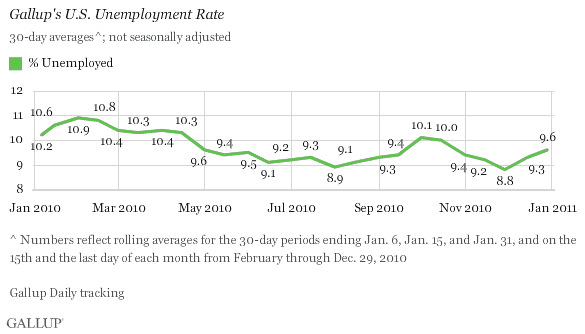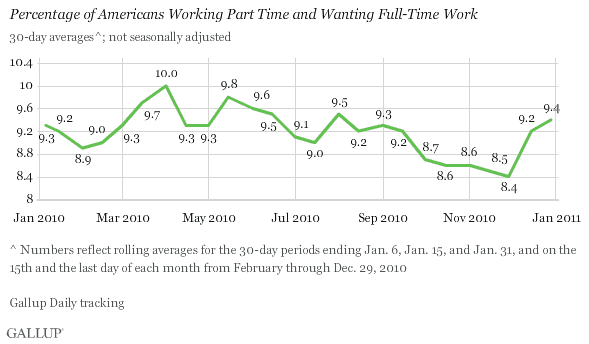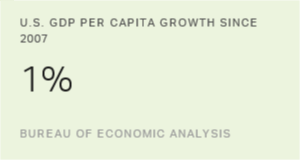PRINCETON, NJ -- Unemployment, as measured by Gallup without seasonal adjustment, increased to 9.6% at the end of December -- up from 9.3% in mid-December and 8.8% at the end of November.

Meanwhile, the percentage of part-time workers who want full-time work increased to 9.4% of the workforce in December -- up from 9.2% in mid-December and 8.4% at the end of November.

Underemployment at 19.0% in December
The increase in Gallup's U.S. unemployment rate and the worsening in the percentage of part-time workers wanting full-time work combined to raise underemployment to 19.0% in December from 18.5% in mid-December and 17.2% at the end of November.

Implications
The U.S. unemployment picture may seem unusually confusing these days. Gallup monitoring showed a sharp improvement in the jobs situation in November, particularly as companies added holiday workers. However, the government surprised Gallup and most other economic observers as it reported last month that the U.S. unemployment rate increased to 9.8% in November. It appears that the government made a larger seasonal adjustment than was generally anticipated for the month.
ADP on Wednesday reported that the economy added 297,000 private-sector jobs -- far above the consensus expectation that the government on Friday will report the U.S. economy added 140,000 new jobs overall in December. In contrast, Gallup shows the unemployment rate increasing as companies let go of holiday workers. At the same time, Gallup's Job Creation Index shows monthly average hiring and firing conditions essentially unchanged over the past three months.
Because the Gallup unemployment measure is not seasonally adjusted, it tends to more accurately reflect what is actually taking place in the U.S. job market -- and may not agree with the government's estimate that is seasonally adjusted. Further, Gallup's data tend to be more up-to-date than the government's because Gallup polls on the unemployment situation continuously. Combined, seasonal adjustments and timing differences likely explain much of the disparity between Gallup's measures of underemployment and unemployment, compared with those reported by others.
Whatever the government reports about unemployment on Friday, Gallup's U.S. underemployment data for the end of 2010 show that nearly one in five Americans continue to be unemployed or employed part-time looking for full-time work. In turn, this underscores the importance of job creation as a top national priority.
Gallup.com reports results from these indexes in daily, weekly, and monthly averages and in Gallup.com stories. Complete trend data are always available to view and export in the following charts:
Daily: Employment, Economic Confidence and Job Creation, Consumer Spending
Weekly: Employment, Economic Confidence, Job Creation, Consumer Spending
Read more about Gallup's economic measures.
View our economic release schedule.
Survey Methods
Gallup classifies American workers as underemployed if they are either unemployed or working part time but wanting full-time work. The findings reflect more than 18,000 phone interviews with U.S. adults aged 18 and older in the workforce, collected over a 30-day period. Gallup's results are not seasonally adjusted and tend to be a precursor of government reports by approximately two weeks.
Results are based on telephone interviews conducted as part of Gallup Daily tracking Nov. 30-Dec. 29, 2010, with a random sample of 18,071 adults, aged 18 and older, living in all 50 U.S. states and the District of Columbia, selected using random-digit-dial sampling.
For results based on the total sample of national adults, one can say with 95% confidence that the maximum margin of sampling error is ±1 percentage point..
Interviews are conducted with respondents on landline telephones and cellular phones, with interviews conducted in Spanish for respondents who are primarily Spanish-speaking. Each daily sample includes a minimum quota of 150 cell phone respondents and 850 landline respondents, with additional minimum quotas among landline respondents for gender within region. Landline respondents are chosen at random within each household on the basis of which member had the most recent birthday.
Samples are weighted by gender, age, race, Hispanic ethnicity, education, region, adults in the household, cell phone-only status, cell phone-mostly status, and phone lines. Demographic weighting targets are based on the March 2009 Current Population Survey figures for the aged 18 and older non-institutionalized population living in U.S. telephone households. All reported margins of sampling error include the computed design effects for weighting and sample design.
In addition to sampling error, question wording and practical difficulties in conducting surveys can introduce error or bias into the findings of public opinion polls.
For more details on Gallup's polling methodology, visit www.gallup.com.
